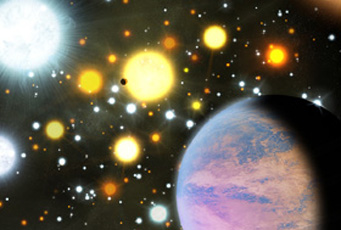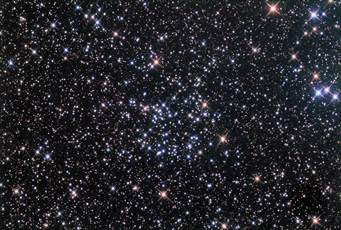The discovery of two mini-Neptunes around Sun-like stars in a distinctly un-Sun-like environment reveals that small planets can live in more crowded neighborhoods than we thought.

An artist's rendition of a mini-Neptune in a cluster packed with bright, young stars.
Michael Bachofner
Most stars form in clusters. Those stars, and the planets they host, grow up surrounded by tens or even thousands of stellar siblings born from the same gas cloud. In the jostling for space, it’s a wonder any planets survive. The question is, how dense is too dense?
Answering that question has been difficult: until now, astronomers had detected only four planets inside clusters, compared to more than 850 planets found orbiting isolated stars in the galactic field. But Soren Meibom (Harvard-Smithsonian Center for Astrophysics) and a team of astronomers recently reported in Nature two mini-Neptunes inside a dense cluster, showing that even stars in the densest clusters can form planets.
The two planets, Kepler 66-b and Kepler 67-b, are slightly smaller than Neptune, each almost three times as wide as Earth. They closely circle Sun-like stars, whipping around every 17.8 and 15.2 days, respectively. But their environment is anything but Sun-like. They live in NGC 6811, a billion-year-old open cluster that was once jam-packed with more than 6,000 stars.
The Sun also grew up in an open cluster. But the Sun’s birthplace was 100 times less dense than NGC 6811, and the surrounding stars went their separate ways over the course of several million years, maybe even before the stars and planets had finished forming. NGC 6811, on the other hand, survived to the present-day, even though it lost some members to gravitational interactions or supernova explosions.
In the jam-packed environs of an open cluster, countless dangers await a forming planet. A gravitational bump from a passing star could disrupt the protoplanetary disk or nearby supernovae explosions might obliterate a newly formed planet.

The billion-year-old open cluster NGC 6811 is over 3,000 light years away and contains about 1,000 stars today (including several O-type stars and more than 100 B stars). At its birth, it probably contained some 6,000 stars.
Anthony Ayiomamitis
NGC 6811 is one of four old and dense open clusters studied in the Kepler Cluster Survey before the planet-hunting spacecraft’s demise.
The glaring brilliance of the most massive stars in these clusters has long since burnt out, so Kepler was able to closely watch 377 fainter, longer-lived stars. So far, two of these stars turn out to host transiting planets.
Two planets around 377 stars — Meibom and his colleagues wondered, was that rate normal? Or did the tightly-packed cluster stifle planet formation? If all the stars in NGC 6811 were field stars, Meibom’s team calculated that they would expect to find between 2 and 6 transiting planets and between 0.7 and 3.7 mini-Neptunes. (Of course, they’re not going to find partial planets, but these figures are based on a statistical study.) The two transiting mini-Neptunes Meibom’s team discovered fall squarely in the middle of the expected range.
They calculated that between 0.1 and 2.3 Earth-sized planets and between 0 and 1.2 giant planets would be detectable — so the fact that the team didn’t find any Earth-sized or giant planets is also expected.
“Whatever the process is that makes planets out of gas clouds, it works in the very dense regions of space where hundreds of stars are formed,” explains Kenneth Janes (Boston University).
The existence of these two mini-Neptunes shows that planets can form just as well in neighborhoods far more crowded and violent than the calm environment of our Sun’s youth. Meibom plans to continue planet-hunting in even denser clusters until he finds the “crowdedness” threshold beyond which planets can’t form.
 8
8
Comments
Carter Hayward
July 9, 2013 at 9:36 am
This news item brought Isaac Asimov’s story, “Nightfall”, to mind (first published in 1941).
You must be logged in to post a comment.
Jeff
July 9, 2013 at 10:02 am
Any idea what percentage of planets in these clusters are still orbiting their parent star when that star has reached, say 50% of its estimated life?
You must be logged in to post a comment.
Shari Balouchi
July 9, 2013 at 11:12 am
Good question, Jeff. So far, only four other planets have been discovered in clusters (3 open, 1 globular). And each case is very different. The mini-Neptunes found in NGC 6811 orbit 1 billion year old G-type stars (let’s say expected lifetime about 10 billion years). The hot Jupiter in globular cluster M4 orbits dead stars (PSR B1620-26 and its white dwarf companion) but the planet is an estimated 13 billion years old. The planet found in the Hyades circled around the orange giant Epsilon Tauri (previously thought to be an A-type star). The two planets in the Beehive cluster were found orbitting late F and G dwarfs.
You must be logged in to post a comment.
Bruce
July 10, 2013 at 7:10 am
This is a very interesting report Shari. Exoplanet fans are sure to welcome this news greatly, for it continues a trend in which planets are being found at more and more sites. This is proving that, just as star formation is a robust process, planetary formation must be as well. But Shari I’m having some difficulty with your fourth paragraph, wherein you wrote, “the Sun’s birthplace was 100 times less dense than NGC 6811, and the surrounding stars went their separate ways over several million years ago, maybe even before the stars and planets had finished forming.” First, how can we be so sure about the density of the Sun’s cluster? And secondly, since the Sun and its fellow cluster members are believed to have formed about 4.6 BYA from a loose cluster, wouldn’t their dispersion have happened far more than just “several million years ago”?
You must be logged in to post a comment.
Mark Olson
July 10, 2013 at 8:56 pm
Would there really be a hundred or more stars showing a disk? If many stars in the cluster were that close, I would not expect there to be any stable orbits. (Nor would I expect any planets to have formed. It would be kind of hot, too.) On the face of it, this is entirely unrealistic.
If I'm correct, why did S&T publish this picture? 100% accuracy is neither possible nor required in a popular science magazine, but I think this falls well short of minimum.
You must be logged in to post a comment.
Shari Balouchi
July 11, 2013 at 7:34 am
Bruce,
You are right,I misphrased that sentence, thank you for holding me accountable. It should read “the Sun’s birthplace was 100 times less dense than NGC 6811, and the surrounding stars went their separate ways over the course of several million years, maybe even before the stars and planets had finished forming.”
Secondly, we are assuming that the Sun was born in a "typical" cluster, as we have no reason to believe otherwise at the moment. The following excerpt is from the paper: "For NGC6811 to have survived a billion years, the initial number density of stars in the cluster must have been at least that of the Orion Trapezium cluster (about 13,000 per cubic parsec) and thus more than two orders of magnitude greater than that of the typical cluster formed in a molecular cloud."
Hope that clears things up!
You must be logged in to post a comment.
Bruce
July 11, 2013 at 11:30 am
Yes that answers my questions very well Shari, and thanks for helping to keep us astronomically up to date.
You must be logged in to post a comment.
Marc
July 15, 2013 at 7:59 am
Is it really likely that there are any O- and B-type stars left in a cluster with an estimated age of 1 billion years? I thought these stars had a lifetime of a couple of 100 million years max and should therefore have long "left the building"...
Or am I missing something?
You must be logged in to post a comment.
You must be logged in to post a comment.